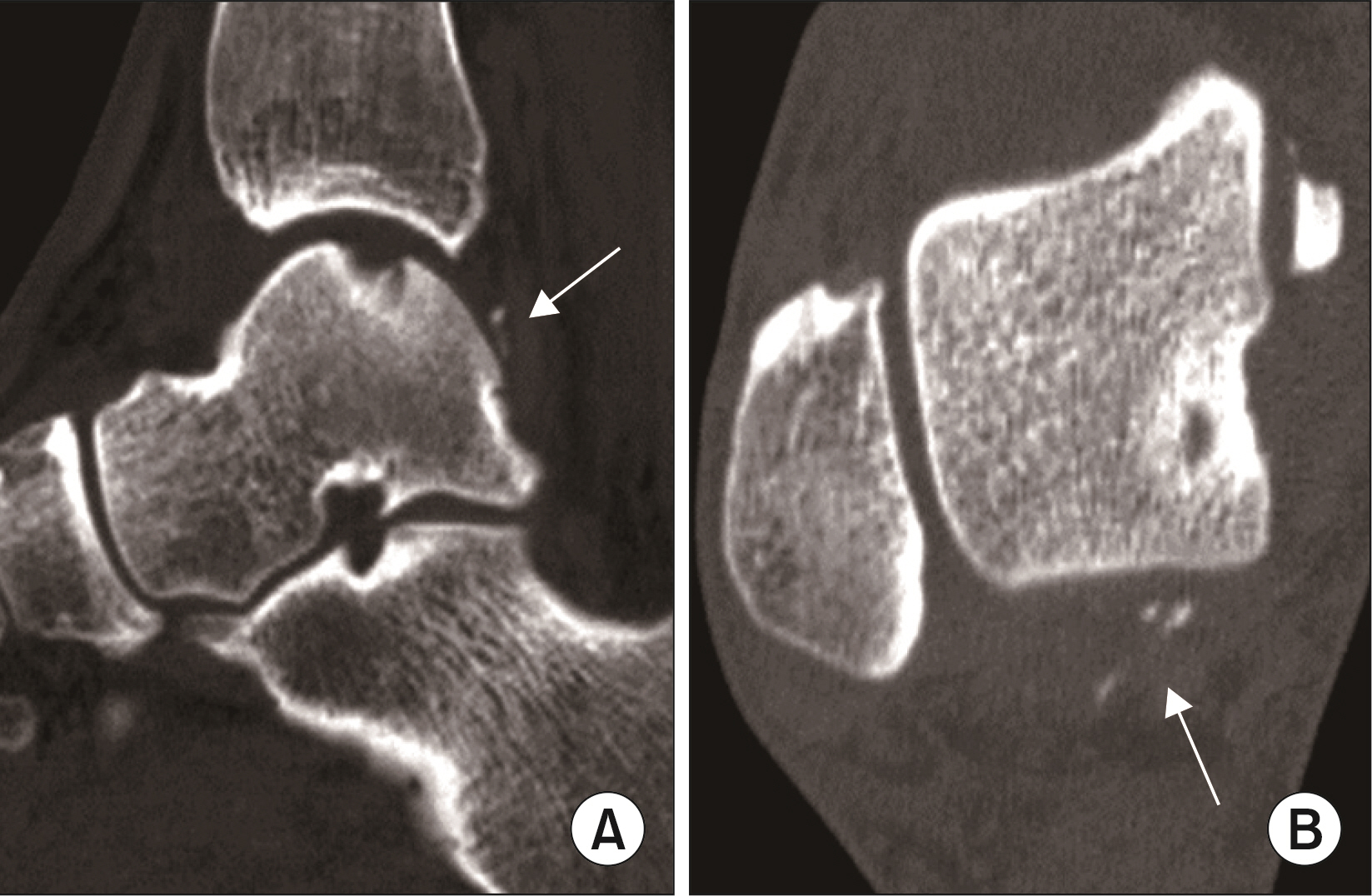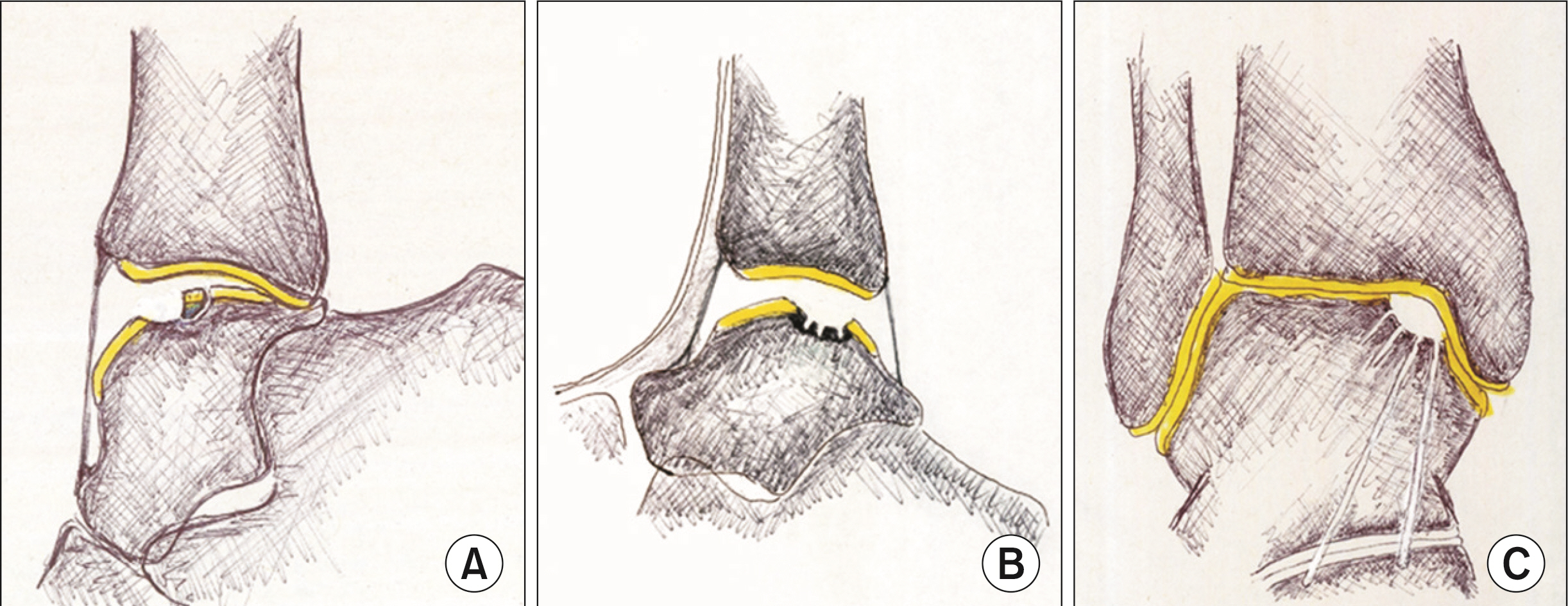J Korean Foot Ankle Soc.
2020 Jun;24(2):69-74. 10.14193/jkfas.2020.24.2.69.
If the Patient Complains Persistent Pain after the Operation, What Should We Do?
- Affiliations
-
- 1Department of Orthopedic Surgery, Samsung Medical Center, SungkyunKwan University School of Medicine, Seoul, Korea
- KMID: 2502912
- DOI: http://doi.org/10.14193/jkfas.2020.24.2.69
Abstract
- Osteochondral lesions of the talus (OLT) can heal and remain asymptomatic, or they can progress to deep ankle pain on weight bearing and the formation of subchondral cysts. Treatment varies from nonoperative treatment to open and arthroscopic procedures. Operative procedures include marrow stimulation techniques (abrasion chondroplasty, multiple drilling, microfracture), osteochondral autografts or allografts, and autologous chondrocyte implantation. Among these treatments, arthroscopic marrow stimulation techniques have been the preferred initial surgical treatment for most OLT. Despite these treatments, many patients complain of persistent pain even after surgery, and many surgeons face the challenge of determining a second line of treatments. This requires a thorough re-evaluation of the patient’s symptoms as well as radiological measures. If the primary surgical treatment has failed, multiple operative treatments are available, and relatively more invasive methods can be administered. On the other hand, it is inappropriate to draw a firm conclusion in which methods are superior.
Keyword
Figure
Reference
-
1. Ray RB, Coughlin EJ Jr. 1947; Osteochondritis dissecans of the talus. J Bone Joint Surg Am. 29:697–706. PMID: 20253044.2. Berndt AL, Harty M. 1959; Transchondral fractures (osteochondritis dissecans) of the talus. J Bone Joint Surg Am. 41:988–1020. DOI: 10.2106/00004623-195941060-00002. PMID: 13849029.
Article3. Canale ST, Belding RH. 1980; Osteochondral lesions of the talus. J Bone Joint Surg Am. 62:97–102. DOI: 10.2106/00004623-198062010-00014. PMID: 7351423.
Article4. Chen DS, Wertheimer SJ. 1992; Centrally located osteochondral fracture of the talus. J Foot Surg. 31:134–40. PMID: 1644999.5. Flick AB, Gould N. 1985; Osteochondritis dissecans of the talus (transchondral fractures of the talus): review of the literature and new surgical approach for medial dome lesions. Foot Ankle. 5:165–85. doi: 10.1177/107110078500500403. DOI: 10.1177/107110078500500403. PMID: 3830846.
Article6. Stone JW. 1996; Osteochondral lesions of the talar dome. J Am Acad Orthop Surg. 4:63–73. doi: 10.5435/00124635-199603000-00001. DOI: 10.5435/00124635-199603000-00001. PMID: 10795042.
Article7. Verhagen RA, Struijs PA, Bossuyt PM, van Dijk CN. 2003; Systematic review of treatment strategies for osteochondral defects of the talar dome. Foot Ankle Clin. 8:233–42. viii–ix. doi: 10.1016/s1083-7515(02)00064-5. DOI: 10.1016/S1083-7515(02)00064-5.
Article8. Thompson JP, Loomer RL. 1984; Osteochondral lesions of the talus in a sports medicine clinic. A new radiographic technique and surgical approach. Am J Sports Med. 12:460–3. doi: 10.1177/036354658401200611. DOI: 10.1177/036354658401200611. PMID: 6507717.9. Clanton TO, DeLee JC. 1982; Osteochondritis dissecans. History, pathophysiology and current treatment concepts. Clin Orthop Relat Res. (167):50–64. doi: 10.1097/00003086-198207000-00009. DOI: 10.1097/00003086-198207000-00009. PMID: 6807595.
Article10. Saxler G, Löer F, Skumavc M, Pförtner J, Hanesch U. 2007; Localization of SP- and CGRP-immunopositive nerve fibers in the hip joint of patients with painful osteoarthritis and of patients with painless failed total hip arthroplasties. Eur J Pain. 11:67–74. doi: 10.1016/j.ejpain.2005.12.011. DOI: 10.1016/j.ejpain.2005.12.011. PMID: 16460974.
Article11. Mach DB, Rogers SD, Sabino MC, Luger NM, Schwei MJ, Pomonis JD, et al. 2002; Origins of skeletal pain: sensory and sympathetic innervation of the mouse femur. Neuroscience. 113:155–66. doi: 10.1016/s0306-4522(02)00165-3. DOI: 10.1016/S0306-4522(02)00165-3. PMID: 12123694.
Article12. Labovitz JM, Schweitzer ME. 1998; Occult osseous injuries after ankle sprains: incidence, location, pattern, and age. Foot Ankle Int. 19:661–7. doi: 10.1177/107110079801901003. DOI: 10.1177/107110079801901003. PMID: 9801079.
Article13. Choi WJ, Choi GW, Kim JS, Lee JW. 2013; Prognostic significance of the containment and location of osteochondral lesions of the talus: independent adverse outcomes associated with uncontained lesions of the talar shoulder. Am J Sports Med. 41:126–33. doi: 10.1177/0363546512453302. DOI: 10.1177/0363546512453302. PMID: 22859663.14. Barnes CJ, Ferkel RD. 2003; Arthroscopic debridement and drilling of osteochondral lesions of the talus. Foot Ankle Clin. 8:243–57. doi: 10.1016/s1083-7515(03)00016-0. DOI: 10.1016/S1083-7515(03)00016-0. PMID: 12911239.
Article15. Choi WJ, Park KK, Kim BS, Lee JW. 2009; Osteochondral lesion of the talus: is there a critical defect size for poor outcome? Am J Sports Med. 37:1974–80. doi: 10.1177/0363546509335765. DOI: 10.1177/0363546509335765. PMID: 19654429.16. Lee KB, Bai LB, Yoon TR, Jung ST, Seon JK. 2009; Second-look arthroscopic findings and clinical outcomes after microfracture for osteochondral lesions of the talus. Am J Sports Med. 37(Suppl 1):63S–70S. doi: 10.1177/0363546509348471. DOI: 10.1177/0363546509348471. PMID: 19843658.
Article17. Schuman L, Struijs PA, van Dijk CN. 2002; Arthroscopic treatment for osteochondral defects of the talus. Results at follow-up at 2 to 11 years. J Bone Joint Surg Br. 84:364–8. doi: 10.1302/0301-620x.84b3.11723. DOI: 10.1302/0301-620X.84B3.11723. PMID: 12002494.18. Zengerink M, Struijs PA, Tol JL, van Dijk CN. 2010; Treatment of osteochondral lesions of the talus: a systematic review. Knee Surg Sports Traumatol Arthrosc. 18:238–46. doi: 10.1007/s00167-009-0942-6. DOI: 10.1007/s00167-009-0942-6. PMID: 19859695. PMCID: PMC2809940.
Article19. Savva N, Jabur M, Davies M, Saxby T. 2007; Osteochondral lesions of the talus: results of repeat arthroscopic debridement. Foot Ankle Int. 28:669–73. doi: 10.3113/FAI.2007.0669. DOI: 10.3113/FAI.2007.0669. PMID: 17592696.
Article20. Higashiyama I, Kumai T, Takakura Y, Tamail S. 2000; Follow-up study of MRI for osteochondral lesion of the talus. Foot Ankle Int. 21:127–33. doi: 10.1177/107110070002100206. DOI: 10.1177/107110070002100206. PMID: 10694024.
Article21. Yoon HS, Park YJ, Lee M, Choi WJ, Lee JW. 2014; Osteochondral autologous transplantation is superior to repeat arthroscopy for the treatment of osteochondral lesions of the talus after failed primary arthroscopic treatment. Am J Sports Med. 42:1896–903. doi: 10.1177/0363546514535186. DOI: 10.1177/0363546514535186. PMID: 24907287.
Article22. DʼAmbrosi R, Villafañe JH, Indino C, Liuni FM, Berjano P, Usuelli FG. 2019; Return to sport after arthroscopic autologous matrix-induced chondrogenesis for patients with osteochondral lesion of the talus. Clin J Sport Med. 29:470–5. doi: 10.1097/JSM.0000000000000560. DOI: 10.1097/JSM.0000000000000560. PMID: 31688177.23. Gu W, Li T, Shi Z, Mei G, Xue J, Zou J, et al. 2017; Management of Hepple stage V osteochondral lesion of the talus with a platelet-rich plasma scaffold. Biomed Res Int. 2017:6525373. doi: 10.1155/2017/6525373. DOI: 10.1155/2017/6525373. PMID: 28401159. PMCID: PMC5376404.
Article24. Park KH, Hwang Y, Han SH, Park YJ, Shim DW, Choi WJ, et al. 2018; Primary versus secondary osteochondral autograft transplantation for the treatment of large osteochondral lesions of the talus. Am J Sports Med. 46:1389–96. doi: 10.1177/0363546518758014. DOI: 10.1177/0363546518758014. PMID: 29537877.
Article25. O'Driscoll SW. 1998; The healing and regeneration of articular cartilage. J Bone Joint Surg Am. 80:1795–812. DOI: 10.2106/00004623-199812000-00011. PMID: 9875939.26. Robinson DE, Winson IG, Harries WJ, Kelly AJ. 2003; Arthroscopic treatment of osteochondral lesions of the talus. J Bone Joint Surg Br. 85:989–93. doi: 10.1302/0301-620x.85b7.13959. DOI: 10.1302/0301-620X.85B7.13959. PMID: 14516033.
Article27. Lambers KTA, Dahmen J, Reilingh ML, van Bergen CJA, Stufkens SAS, Kerkhoffs GMMJ. 2018; No superior surgical treatment for secondary osteochondral defects of the talus. Knee Surg Sports Traumatol Arthrosc. 26:2158–70. doi: 10.1007/s00167-017-4629-0. DOI: 10.1007/s00167-017-4629-0. PMID: 28687862. PMCID: PMC6061445.
Article28. Kim YS, Park EH, Kim YC, Koh YG. 2013; Clinical outcomes of mesenchymal stem cell injection with arthroscopic treatment in older patients with osteochondral lesions of the talus. Am J Sports Med. 41:1090–9. doi: 10.1177/0363546513479018. DOI: 10.1177/0363546513479018. PMID: 23460335.
Article29. Murphy EP, McGoldrick NP, Curtin M, Kearns SR. 2019; A prospective evaluation of bone marrow aspirate concentrate and microfracture in the treatment of osteochondral lesions of the talus. Foot Ankle Surg. 25:441–8. DOI: 10.1016/j.fas.2018.02.011. PMID: 30321966.
Article30. Ross AW, Murawski CD, Fraser EJ, Ross KA, Do HT, Deyer TW, et al. 2016; Autologous osteochondral transplantation for osteochondral lesions of the talus: does previous bone marrow stimulation negatively affect clinical outcome? Arthroscopy. 32:1377–83. doi: 10.1016/j.arthro.2016.01.036. DOI: 10.1016/j.arthro.2016.01.036. PMID: 27062010.
Article31. Imhoff AB, Paul J, Ottinger B, Wörtler K, Lämmle L, Spang J, et al. 2011; Osteochondral transplantation of the talus: long-term clinical and magnetic resonance imaging evaluation. Am J Sports Med. 39:1487–93. doi: 10.1177/0363546510397726. DOI: 10.1177/0363546510397726. PMID: 21372316.32. Giannini S, Buda R, Vannini F, Di Caprio F, Grigolo B. 2008; Arthroscopic autologous chondrocyte implantation in osteochondral lesions of the talus: surgical technique and results. Am J Sports Med. 36:873–80. doi: 10.1177/0363546507312644. DOI: 10.1177/0363546507312644. PMID: 18227232.33. Valderrabano V, Miska M, Leumann A, Wiewiorski M. 2013; Reconstruction of osteochondral lesions of the talus with autologous spongiosa grafts and autologous matrix-induced chondrogenesis. Am J Sports Med. 41:519–27. doi: 10.1177/0363546513476671. DOI: 10.1177/0363546513476671. PMID: 23393079.
Article34. Vuurberg G, Reilingh ML, van Bergen CJA, van Eekeren ICM, Gerards RM, van Dijk CN. 2018; Metal resurfacing inlay implant for osteochondral talar defects after failed previous surgery: a midterm prospective follow-up study. Am J Sports Med. 46:1685–92. doi: 10.1177/0363546518764916. DOI: 10.1177/0363546518764916. PMID: 29624081. PMCID: PMC5985591.
Article35. Hintermann B, Wagener J, Knupp M, Schweizer C, J Schaefer D. 2015; Treatment of extended osteochondral lesions of the talus with a free vascularised bone graft from the medial condyle of the femur. Bone Joint J. 97:1242–9. doi: 10.1302/0301-620X.97B9.35292. DOI: 10.1302/0301-620X.97B9.35292. PMID: 26330592.
Article
- Full Text Links
- Actions
-
Cited
- CITED
-
- Close
- Share
- Similar articles
-
- TENS for controlling orthodontic pain
- Persistent idiopathic facial pain treated with botulinum toxin and pulsed radiofrequency of infraorbital nerve – a case report
- Cervical Spinal Epidural Hematoma Following Cervical Posterior Laminoforaminotomy
- Lumbar Sympathectomy in the Management of Rectal Tenesmoid Pain
- Septic Hip Arthritis with Iliopsoas Abscess Detected after Spine Operation: A Case Report



